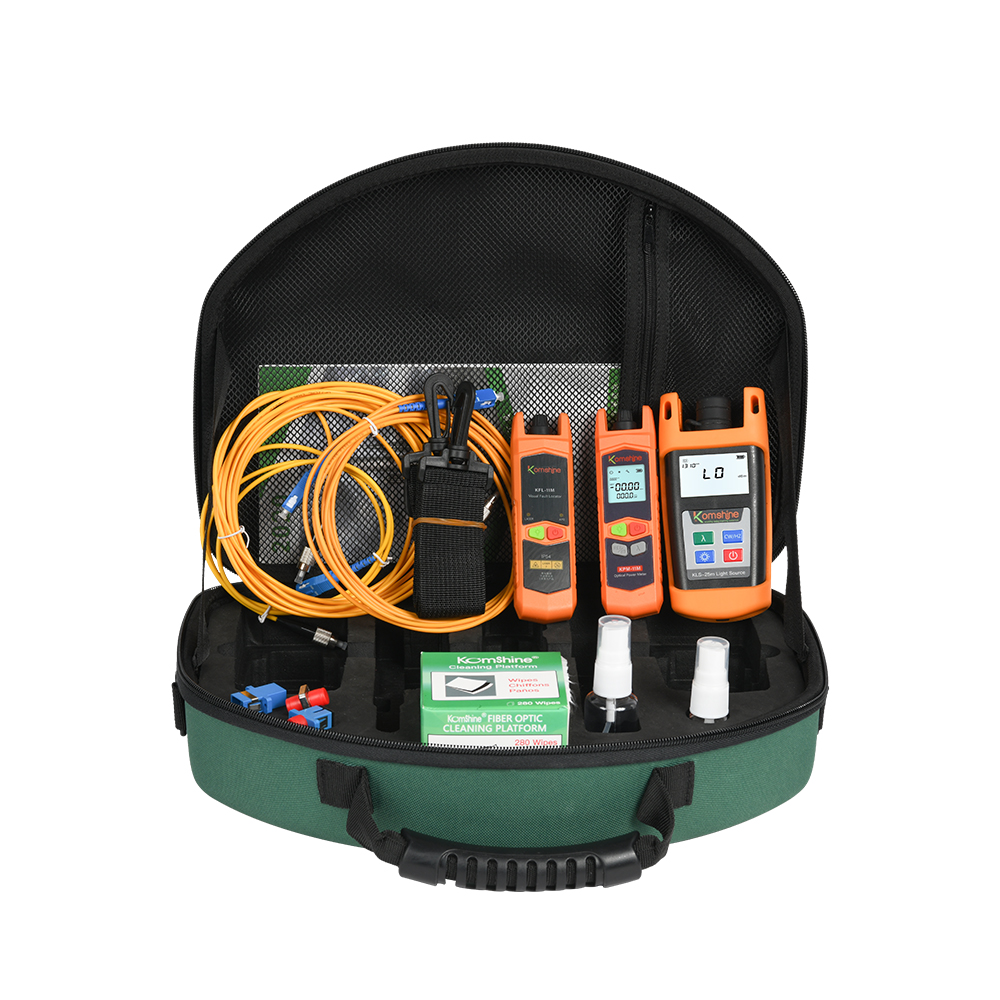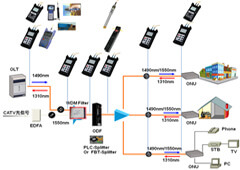Common issues solved by modern fibre testing equipment
Wiki Article
Recognizing Just How an Optical Measurement System Improves Precision in Industrial Applications
Optical measurement systems play a necessary role in improving precision across various commercial applications. By leveraging innovative modern technologies such as laser interferometry and 3D imaging sensors, these systems use high-resolution, non-contact measurements. This capacity reduces the threat of damaging delicate components while making sure accuracy. Nevertheless, the influence of these systems expands past plain measurements. Discovering their benefits, applications, and future fads discloses a complex landscape of technology and challenges that qualities more detailed evaluation.The Fundamentals of Optical Measurement Systems
Optical measurement systems function as important devices in different commercial applications, supplying precise data collection and evaluation. These systems use light as a key methods of measurement, leveraging optical concepts to analyze measurements, positions, and surface area attributes of items. They integrate components such as lasers, video cameras, and sensing units, which collaborate to catch high-resolution photos and information.The modern technology makes it possible for non-contact dimensions, lessening the threat of damaging sensitive parts. Optical measurement systems are versatile, locating energy in quality assurance, setting up confirmation, and dimensional evaluation throughout various industries. They are especially effective in settings where traditional measurement techniques might drop short, such as gauging complicated geometries or observing quick movements.
As markets remain to progress, the integration of optical measurement systems will certainly remain essential for guaranteeing precision and effectiveness, inevitably boosting product top quality and functional efficiency in different manufacturing processes.
Secret Technologies Behind Optical Measurement
Secret technologies such as laser interferometry methods and 3D imaging sensing units play a vital duty in the performance of optical measurement systems (robotic vision). These innovations make it possible for exact measurements and detailed analysis in various industrial applications. Recognizing their functionalities is essential for using the complete capacity of optical measurement systemsLaser Interferometry Techniques
Countless laser interferometry techniques have changed the area of optical measurement, offering extraordinary accuracy and precision in different industrial applications. These strategies use the disturbance of meaningful light waves to measure distance, variation, and surface irregularities with nanometer-level accuracy. Common methods consist of Michelson interferometry, which splits a beam of light of light and assesses phase shifts, and Fabry-Pérot interferometry, known for its high resolution in determining tiny modifications. Additionally, laser Doppler interferometry uses regularity shifts to evaluate speed, making it very useful in dynamic measurements. The flexibility of these strategies permits their assimilation into diverse manufacturing processes, enhancing quality assurance and ensuring adherence to stringent resistances. Consequently, laser interferometry remains to play a critical role ahead of time industrial measurement requirements.3D Imaging Sensors
Innovations in measurement innovation have caused the advancement of 3D imaging sensors, which play a substantial duty in optical measurement systems. These sensors catch three-dimensional information through numerous strategies such as triangulation, time-of-flight, and structured light. By properly reconstructing the form and measurements of objects, 3D imaging sensors improve the precision of measurements in industrial applications. They supply real-time comments, facilitating quality assurance and making sure that parts fulfill rigorous specs. Additionally, their ability to operate in difficult environments, such as varying illumination problems, makes them very useful in manufacturing procedures. As sectors progressively embrace automation, the integration of 3D imaging sensors right into optical measurement systems is expected to drive further improvements in effectiveness and precision.Advantages of Optical Measurement in Sector
Although traditional measurement approaches have long been the requirement in industrial setups, optical measurement systems supply significant benefits that enhance accuracy and performance. These systems utilize light to capture information, leading to high-resolution measurements that are usually unattainable with standard strategies. The non-contact nature of optical dimensions minimizes the threat of damaging sensitive elements throughout the analysis process. Furthermore, the rate of optical dimensions enables fast data purchase, helping with timely decision-making in busy industrial atmospheres.Optical systems are versatile, capable of gauging different materials and shapes without the requirement for substantial recalibration. This adaptability adds to boosted process and performance. Moreover, the automation capacity of optical measurement systems decreases human mistake, ensuring constant quality control. Generally, the integration of optical measurement modern technology stands for a modern change in the direction of improved accuracy and reliability in commercial operations, inevitably leading to boosted product top quality and operational effectiveness.
Applications of Optical Measurement Systems

Optical measurement systems play a crucial duty in boosting manufacturing procedure optimization by giving specific information for decision-making. These systems guarantee quality assurance assurance through real-time surveillance and analysis of manufacturing metrics. As markets significantly adopt these innovations, their effect on performance and item reliability comes to be noticeable.
Production Refine Optimization
Enhancing production procedure effectiveness is increasingly dependent on the combination of optical measurement systems. These systems give real-time information on numerous criteria, enabling producers to evaluate procedures with a high level of precision. By making it possible for exact dimensions of measurements, surface area qualities, and material residential properties, optical measurement systems help with the recognition of ineffectiveness and traffic jams in assembly line. The prompt responses from these systems equips designers to make enlightened choices, resulting in enhanced machining, setting up, and ending up procedures. The ability to check problems continuously permits for flexible adjustments, lessening useful site downtime and waste. As markets go for higher productivity and minimized operational prices, optical measurement systems arise as critical devices for enhancing production process optimization.
High Quality Control Guarantee
The integration of optical measurement systems greatly impacts quality control assurance in commercial settings. These systems supply accurate and non-destructive measurements, allowing manufacturers to detect defects and discrepancies early in the production procedure. By making use of sophisticated imaging methods, such as laser triangulation and interferometry, optical measurement systems imp source assure that parts satisfy strict specs. This helps with real-time monitoring, reducing waste and reducing the risk of faulty items getting to the marketplace. Additionally, the data collected can be analyzed to fine-tune manufacturing procedures further, resulting in continuous improvement. Inevitably, the fostering of optical measurement systems improves integrity and uniformity in quality assurance, cultivating higher confidence among stakeholders and consumers alike in the final products provided.Case Studies: Effective Executions
Many sectors have actually efficiently integrated optical measurement systems to improve their operational efficiency and item high quality. In the vehicle field, a popular maker adopted a laser triangulation system to check the alignment of vehicle components. This application substantially lowered assembly mistakes, causing improved safety and decreased prices.In the aerospace sector, a leading airplane producer made use of optical width for accuracy dimensions of wind turbine blades, achieving a reduction in making tolerances and far better performance criteria.
Likewise, a customer electronics business implemented optical measurement innovation during the manufacturing of mobile phone displays, leading to boosted top quality visit this website control and a decline in faulty items.
These situation research studies illustrate just how optical measurement systems not just boost accuracy however also contribute to total operational performance, demonstrating their worth throughout various industries. By attending to certain needs, these systems have shown to be indispensable tools in modern-day commercial applications.
Obstacles and Limitations of Optical Measurement
While optical measurement systems provide significant benefits in various industrial applications, they are not without their difficulties and restrictions. One significant problem is sensitivity to environmental conditions, such as temperature fluctuations, moisture, and dirt, which can adversely influence measurement precision. Furthermore, optical systems commonly need accurate positioning and calibration, making them at risk to human mistake during configuration and procedure. Another restriction is the potential for interference from ambient light, which can misshape dimensions and necessitate intricate filtering techniques. Certain materials and surfaces may offer troubles, as reflective or transparent characteristics can lead to inconsistent analyses. The expense of top quality optical elements and systems can additionally be an obstacle for some markets, restricting extensive fostering. Specialized training is frequently required for personnel to efficiently run and keep these systems, including to the general complexity and functional obstacles.Future Trends in Optical Measurement Innovation
As developments in innovation continue to form industrial procedures, the future of optical measurement systems is poised for significant advancement. Emerging patterns suggest a change in the direction of boosted integration of fabricated knowledge and artificial intelligence, allowing systems to assess information in real-time, determine patterns, and boost decision-making processes. Furthermore, the growth of miniaturized sensors and progressed optics is anticipated to cause more portable and functional measurement options, making them accessible for a larger series of applications.Furthermore, the incorporation of 3D imaging and high-resolution abilities will allow for unprecedented precision in dimensions, which is necessary for markets such as aerospace and vehicle. The push for automation and Market 4.0 will certainly also drive the demand for optical measurement systems that can conveniently interface with various other modern technologies. As these trends unravel, optical measurement systems will likely come to be essential to achieving higher performance and precision throughout various industrial markets.

Frequently Asked Concerns
How Do Optical Measurement Systems Contrast to Conventional Measurement Techniques?
Optical measurement systems use greater precision and rate compared to standard techniques - fibre testing equipment. They minimize human mistake, improve data collection efficiency, and provide real-time outcomes, making them progressively chose in various commercial applications for specific dimensionsWhat Industries Advantage one of the most From Optical Measurement Systems?
Optical measurement systems considerably profit industries such as aerospace, automobile, and electronics. Their capacity to supply high-precision measurements boosts quality control, decreases production errors, and boosts total performance, making them crucial in affordable production atmospheres.Can Optical Measurement Systems Be Custom-made for Specific Applications?
Optical measurement systems can without a doubt be customized for certain applications. By readjusting parameters such as wavelength, resolution, and calibration methods, sectors can customize these systems to meet unique accuracy and precision requirements successfully.What Is the Maintenance Demand for Optical Measurement Systems?
The maintenance requirements for optical measurement systems normally consist of normal calibration, cleansing of optical parts, and software program updates. Complying with these methods assurances accuracy, reliability, and longevity of the measurement equipment in different applications.Just How Do Ecological Aspects Impact Optical Measurement Precision?
Environmental elements, such as temperature level fluctuations, moisture, and dirt, significantly effect optical measurement accuracy. These elements can distort light paths and disrupt sensing unit readings, eventually compromising the reliability and precision of measurements in industrial setups.Report this wiki page